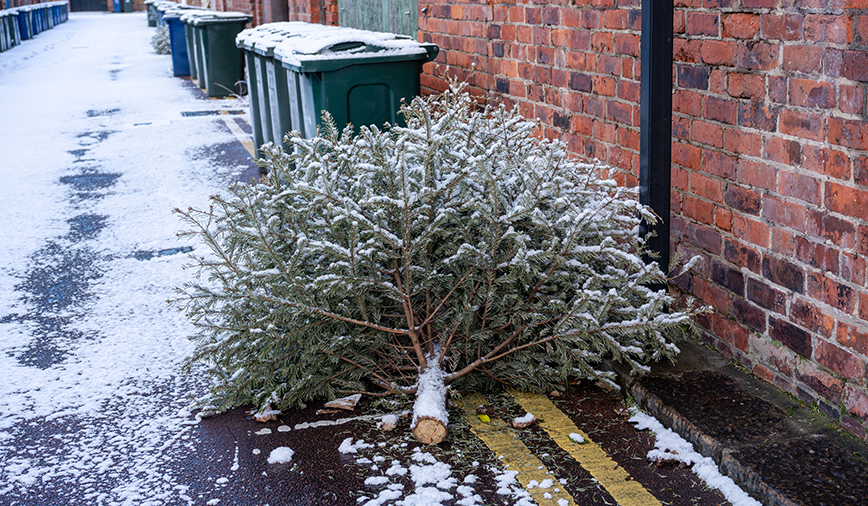January 3, 2014
Treecycling
“Deck the Halls” is one of those infectious Christmas songs that tells you exactly what you need to do to make your holiday festive—besides boughs of holly, you don your gay apparel, troll ancient Yuletide carols, strike the harp, join the chorus, etc. etc.
But what happens when all your decking, donning and trolling is done?
Although ancient boughs of holly likely were dried and reused, or recycled into compost (or possibly composte, as the song’s roots date back to the 16th Century), today’s extravagant, modern traditions bring with them an equally elaborate array of modern problems. What’s the best way to dispose of O Christmas Tree? And what about those Christmas lights? You know, the ones that, O Shoot, won’t work anymore?
Thankfully, our friends at Kane County Recycles and Advanced Disposal have some easy, and earth-friendly, tips that can help put the fa-la-la back in your halls, even as you un-deck them.
For those of us who prefer the look, feel and scent of a live Christmas tree, your disposal options may lie as close as your front curb. Advanced Disposal will be providing free pickup during the weeks of January 6 and 13 in Batavia, Geneva and St. Charles. Other waste haulers and municipalities are offering similar services. A comprehensive list was run in the December 23 issue of the Kane County Chronicle and also can be found online at http://www.countyofkane.org/Recycling/Pages/christmastreerecycling.aspx.
This option is certainly convenient, but is it green, in an eco-friendly sense? I called Advanced Disposal and learned that the company’s trucks bring Christmas trees to the company’s transfer facility, from which they are then transported to Compost Supply (motto: Giving new life to old dirt) in Sheridan.
Not bad! For the cost of some fossil fuels and truck traffic, neither of which you pay for directly, all the good things that went into growing your holiday tree can be returned to the soil for use again…maybe as nourishment for a new Christmas tree that is still young and growing.
But what if you’re in the market for other uses for Der Tannenbaum? Although it doesn’t provide use for the whole tree, one of my favorite things to do with pine tree trunks is to slice them into “tree cookies.” Complete instructions are available at the Minnesota Department of Natural Resources’ web site (http://files.dnr.state.mn.us/education_safety/education/plt/activity_sheets/treeCookie.pdf) but the general idea is to let the trunk dry thoroughly, then slice with a saw to produce “cookies.” Sand and seal and you have the perfect blank canvas for ornaments, wall hangings, drink coasters or other art projects. Pine boughs left over from this project can be laid beneath acid-loving plants to provide nutrients.
Speaking of pine boughs, all those that were wound up with wire to produce fresh wreaths and garlands are not recyclable curbside. But you can still make use of them. Remove wires, ribbons and any other inorganic decorations then, as above, lay them beneath shrubs and herbaceous plants that like a little acid in their soil.
Then there is the conundrum of artificial trees. Are they really a greener option for holiday décor?
The same tree, used year after year, certainly is a green concept. But what happens when it’s time to retire a tired artificial ‘Baum’?
If it’s still in usable condition, you can always list it on Craigslist or donate it at one of our areas many fine resale shops. (But if you opt for the latter, be sure to call first, as many operations have limited storage space and only accept Christmas items in the weeks before, as opposed to after, the holiday.)
Here too you can get creative and, instead of looking at the tree as a whole, consider its parts. Can its boughs be separated and wound into reusable wreaths or garland? Can you tie a branch
or two together to create swags for outdoor light fixtures? Possibilities are as endless, and evergreen, as your own imagination.
Now, pre-lit artificial Christmas trees can provide their own challenges, especially when the wired-on lights start to go bad. “Monstrous hybrids,” says Jennifer Jarland, Kane County’s recycling coordinator. She gives credit for the term to Cradle to Cradle, a book by architect William McDonough and chemist Michael Braungart that makes a solid case for new manufacturing processes to eliminate waste altogether.
With lights that are structurally integrated into the tree, when one or the other goes bad the user has few choices other than to send the “monstrosity” to the landfill. Jarland suggests a possible solution is to just keep using the tree, even with its temperamental light strands. We agree. At Hickory Knolls, where an aging prelit tree graces our lobby, we’ve simply purchased additional lights and plugged them in on a separate circuit whenever we’ve been unable to repair sections that have gone dark. Once decorated, the supplemental strings aren’t even noticeable. The result: One 10-ft. “monster” diverted from a landfill.
As for strings of lights…is it just my imagination, or are newer strands really only built to last a season or two? If you, like me, have tried replacing bulbs and fuses to no avail, Jarland offers another solution. “Christmas tree lights can be brought to our monthly electronics recycling events, or any of our permanent drop-off locations.” (Electronics recycling occurs on the second Saturday of each month, from 8am to 12pm, in the lot behind the office of the Kane County Circuit Clerk, 540 S. Randall Road, St. Charles. Locations and hours for permanent electronics drop-off locations can be found at http://www.countyofkane.org/Recycling/Pages/electronics/otherLocations.aspx.)
Pam Otto is the manager of nature programs and interpretive services at the Hickory Knolls Discovery Center, a facility of the St. Charles Park District. She can be reached at 630-639-7960 or potto@stcparks.org.

